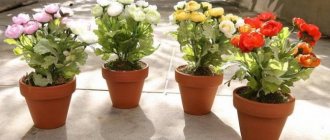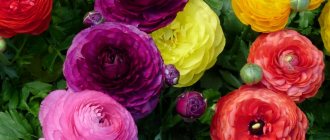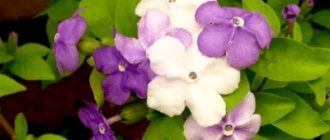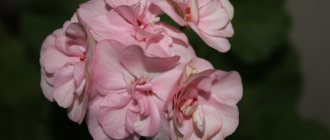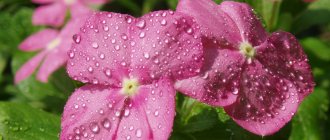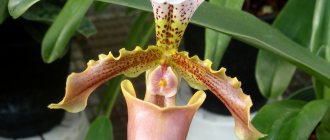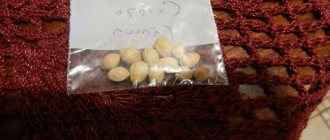Ranunculus is a beautifully flowering rhizomatous plant of the Ranunculaceae family. It grows in small neat bushes from 20 cm to 80 cm in height. On straight stems there are strongly dissected dark green leaves and peony-shaped flowers with a different number of petals - from semi-double to densely double. The variety of colors and compact shape make it possible to grow ranunculus in the garden or as an indoor flower.
Preparing tubers for planting
Ranunculus rhizomes are spider-like nodules ranging in size from 1.5 to 3 cm.
Tubers are planted either immediately in a flower garden in a permanent place, or in a container for home germination. They are carefully inspected - there should be no mold or rotting areas.
Before planting, the tubers are soaked. To prevent diseases, use a solution of the biological fungicide Fitosporin. To stimulate growth and increase protective forces, stimulants Epin, Zircon, NV-101 are used. Solutions are prepared strictly following the instructions for the preparations. Soaking in water or a weak solution of potassium permanganate for 2–3 hours is allowed. The liquid should not cover the entire rhizome to ensure access to oxygen. Immediately after the procedure is completed, planting begins.
4 common types of garden violets that will become an indispensable flowerbed decoration
Ranunculus propagation
Among the main methods of propagation of ranunculus are tubers and seeds. Reproduction by shoots is rarely used due to the gradual degeneration of the crop.
Tubers
Thanks to several shoots, ranunculus tubers evoke associations with a crow's foot. The largest specimens with at least 4 shoots are selected for cultivation. Only dense and hard tubers, well saturated with moisture, are suitable.
When planting, the bud should be in a vertical position relative to the ground. Even a slight tilt can lead to the death of the plant. It is considered correct to deepen the ranunculus tubers with your fingers down.
Seeds
The low germination rate of garden buttercup seeds is the reason for the unpopularity of this growing method. Ranunculus seeds are collected from the first faded buds, having previously wrapped them in gauze so that they do not fall off. The process of propagating garden buttercups by seeds is described in detail in the section “Growing seedlings.”
By shoots
At the end of the ranunculus growing season, up to 7 young shoots are formed on the tuber. They are rarely used for further cultivation, since the characteristics of the plant noticeably deteriorate: garden buttercup flowers become smaller, less saturated in color and weaker.
Planting tubers
It is better for plants to immediately determine a permanent place, since they do not like transplanting. Plant in open ground after the soil warms up to +10° and above. Usually this is the beginning of May. The soil is slightly moistened. At a distance of 10–15 cm, dig holes 5–8 cm deep. The rhizomes are lowered to the bottom with their “legs” down. Sprinkle with earth. The planting site is watered and covered with covering material for the first time, until the threat of frost has passed.
At home, ranunculus are planted for germination in early April. To do this, it is convenient to use flower pots with drainage holes in the bottom, boxes with a height of at least 10 cm, and individual peat or plastic cups. Before planting, wash the container thoroughly. Drainage is placed at the bottom. This could be expanded clay, perlite, fragments of polystyrene foam, eggshells. Make small depressions and plant the nodules with their “legs” down, leaving the top open. Then water with a solution of a fungicide or growth stimulator.
Pots with planted rhizomes are placed in a bright place at a temperature of +16–18°. If the daylight hours are less than 12 hours, the seedlings must be supplemented with light. Water with warm, settled water. If there is a lack of water, the plants wither; if there is too much, the rhizomes can rot.
If the air in the room is too dry, you should place an open container of water nearby or use a humidifier. Once every two weeks, seedlings are fed with complex mineral fertilizer in a dosage half as much as indicated in the instructions for adult plants.
Summarizing
Ranunculus is a gorgeous flower that even a queen deserves. However, it has a number of features that place it in the category of demanding plants.
- Too demanding to care for, not suitable for beginner gardeners.
- Ranunculus has weak and sensitive roots.
- The plant is sensitive to transplants.
- Flowering occurs only with 100% compliance with the conditions of maintenance.
- Has a long rest period.
- Not long-lived.
- Not frost-resistant.
- Difficult to adapt to environmental conditions.
Despite its harmless appearance, Ranunculus contains poisonous juice, be careful and keep children away from it
Sowing seeds and caring for seedlings
Sow in February. The seeds are soaked in a solution of a growth stimulator. The substrate is placed in a container, moistened, and leveled. Seeds are placed on damp soil at a distance of 2–3 cm. Sprinkled with earth or sand in a 3 mm layer. The top of the container is covered with glass or transparent film.
Growing poppies on your own site: what types of flowers can be planted in a flower bed
Place it in a bright place. The optimal temperature is +15–17°. Periodically moisten the soil with a spray bottle. The greenhouse is ventilated daily for 10–15 minutes. After 5 days, the container with seedlings is transferred to heat with an air temperature of +22–24°. After 2–3 weeks, the first shoots appear and the seedlings are returned to their previous conditions. Immediately remove the glass or film. When the second pair of leaves appears, they begin to pick and plant them in separate pots.
Watering
For its love of groundwater and marshy places, Ranunculus is called a frog, but this does not mean that it can be watered without measure. When watering a flower, you need a golden mean. You need to water frequently, but not too vigorously. There is no clear watering schedule. It depends on how much light hits the flower, what the air temperature is, and how many tubers are in the pot. The reference point is the dryness of the soil. During the period of active growth or flowering, fertilizers can be added to the water for irrigation.
The water for watering the Ranunculus flower is soft, clean, without chlorine impurities. In summer, rainwater is suitable for it, and in winter, melt water. If possible, use spring water, as well as water passed through a carbon filter.
Planting seedlings in open ground
Planting time depends on soil temperature. When it warms up to +10°, you can start planting. The seedlings are watered abundantly within 2 hours. In the flower garden, holes are made at a distance of 10–15 cm from each other and the size is slightly larger than a pot of seedlings. Carefully remove the seedling, trying not to destroy the earthen lump, and carefully roll it into the hole. Cover with earth, lightly compact, and water with warm water. The planting depth in open ground must exactly match the depth in the pot. It is advisable to mulch the plantings with sawdust, peat, and pine bark.
Seedlings obtained from seeds bloom only in the second year. Ranunculus from nodules will bloom this season with proper agricultural practices.
Key Features
The plant is perennial, with an average height of 40 to 50 cm. Buttercup has strong, tuberous roots, so reminiscent of tiny spiders. Beautiful, strongly dissected leaves of green color, with an emerald tint. Each tuber produces 4 peduncles.
On such a peduncle, from 1 to 10 flowers are formed, with different diameters. Flowers bloom all summer, one after another. With double and semi-double petals. Colors: all colors of the rainbow, except blue shades.
Like all tuberous crops, ranunculus lives in cycles from year to year. With the arrival of spring, the first cycle begins: the growing season, from bud break to flowering to seed formation.
The second cycle begins with the withering and death of the entire above-ground part (stem, leaves, flowers) and at the same time the tuber ripens in the underground part. the third cycle includes winter hibernation of the plant; during hibernation, flower buds are laid on the tuber. And then everything repeats again.
Buttercup belongs to ephemeroid plants.
Breeders are developing varieties that have larger flowers and different colors, with a longer flowering period. Varieties are developed that are planted specifically on borders.
Low plants grown in pots look very beautiful on balconies or loggias. Of course, multi-colored buttercups will decorate any garden. Let's see how we can sort through a large assortment.
Caring for an adult plant in the garden
In order for the plant to be strong and healthy, it is necessary to provide it with optimal care.
- Watering should be systematic, but without fanaticism. Excessive moisture can cause the rhizomes to rot, causing mold to appear on the leaves and buds to fall off.
- After watering, it is advisable to loosen the soil.
- Fertilizing is carried out once every 2 weeks with potassium fertilizer. Mixtures based on vermicompost work well.
- A necessary condition for spectacular flowering is the timely removal of wilted flowers.
- Periodically, the bushes are inspected for the presence of pests. When aphids, thrips or spider mites appear, ranunculi are treated with insecticides.
5 useful tips for planting catharanthus in open ground
In the fall, when the leaves and shoots turn yellow, wither and dry out, they are cut off. The nodules are dug up, cleaned, and pickled in a fungicide solution for 30 minutes. Then they are air-dried in the shade for about 3 days and only after that they are put away for storage. Since they cannot tolerate cold, they are stored at a temperature of +4–6° and humidity not higher than 60%. The tubers are carefully covered with dry moss and placed in a paper bag.
Origin
Ranunculus (lat. Ranunculus) , or Asian buttercup (garden) is a herbaceous perennial plant of the buttercup family that came to us from Asia Minor. Its name means “frog” in Latin, and this is not without reason. In the wild, many buttercups prefer flooded areas and high air humidity, along with good ventilation and sufficient warmth.
Having arrived in England in the 16th century, this flower quickly gained popularity among flower growers, but retained its position only until the end of the 19th century. After a long break, Ranunculus again ascended to the flower pedestal. The hard work of breeders has contributed to the emergence of more than 600 varieties of Ranunculus.
Caring for an adult plant at home
Growing ranunculus as an indoor flower is not difficult, but it has its own subtleties:
- When the shoots reach 6–8 cm, the plant is transferred to a bright, sunny room with an air temperature of +20–22°. It is better to use windows facing south for this. In summer, in warm weather, flowers feel comfortable on open balconies and terraces.
- Watering systematically when the top layer dries. Overmoistening should not be allowed. You can periodically spray the leaves with warm water.
- Twice a month the plants are fed with complex fertilizer for flowering indoor plants.
- When the buttercup fades, it is transferred to the shade. After the above-ground parts turn yellow and dry, the stems are cut off. The flower is transplanted into fresh soil and placed in a dark place with a temperature of +15–18° for a month.
When young sprouts appear from the ground, the plant is carefully dug up and the rhizome is divided. Tubers can be planted in new pots.
Growing ranunculus is not difficult, even for novice gardeners. High-quality planting material and compliance with agricultural technology are the key to their lush flowering.
2.Varieties:
2.1. Asian ranunculus - Ranunculus asiaticus
Attractive flowering bulbous perennials 30 - 60 cm high with erect shoots and dark green, glossy, carved leaves reminiscent of parsley. The flowers are wide open, cup-shaped, reminiscent of a poppy, the flower size reaches 5 cm, and can be colored in yellow, pink, red, and white shades. Anthers are black.
↑ Up,
2.2. Persian ranunculus - Ranunculus Persian
A variety of Asian buttercup, often found in flower culture. Depending on the specific variety, the height of the plant can vary from 25 to 60 cm. Plants of this species have simply huge, double flowers with many round, thin petals. The diameter of the flowers can reach 15 cm. The shades of the flowers are often delicate, pastel, in a very diverse range of colors, excluding only black and blue shades.
↑ Up,
2.3.Ranunculus bulbosus - Ranunculus bulbosus
A flowering perennial herbaceous plant with a height of 10 to 30 cm. The bushes have thin, erect stems and dark green, carved, complex leaves on long and thin petioles. Leaves can consist of several segments and are arranged alternately. The flowers are single, golden yellow, cup-shaped, with rounded, wide, glossy petals, reaching 1.5 - 3 cm in diameter. This variety is often found in gardens as a weed.
The above-ground parts of this plant are used in homeopathy to treat herpes zoster, intercostal neuralgia, rheumatism and upper respiratory tract diseases, and relieve epilepsy attacks.
↑ Up,
2.4. Creeping ranunculus or repens - Ranunculus repens
Low plants, reaching a maximum height of about 30 cm. Plants have lodging, thin stems and over time are able to form dense herbaceous mats. The leaves are glossy, dark green, compound and consist of three toothed segments. Peduncles are abundantly covered with silvery pubescence. The flowers are golden-yellow, about 2.5 cm in diameter, appear on plants in May and almost until frost.
↑ Up,
Pests
Some of the most common pests that can sometimes attack Asian buttercups in the garden include aphids, thrips and spider mites. Most often they can appear on plants in dry, hot weather.
To prevent this from happening, for preventive purposes, periodically spray your ranunculi with a weak solution of Mercaptophos, in concentrations of no more than 0.2%. If insects have already appeared on the plants, treatment with insecticides will help.
© Ilya Vladimirovich | 2016-04-12 He's also a gardener
